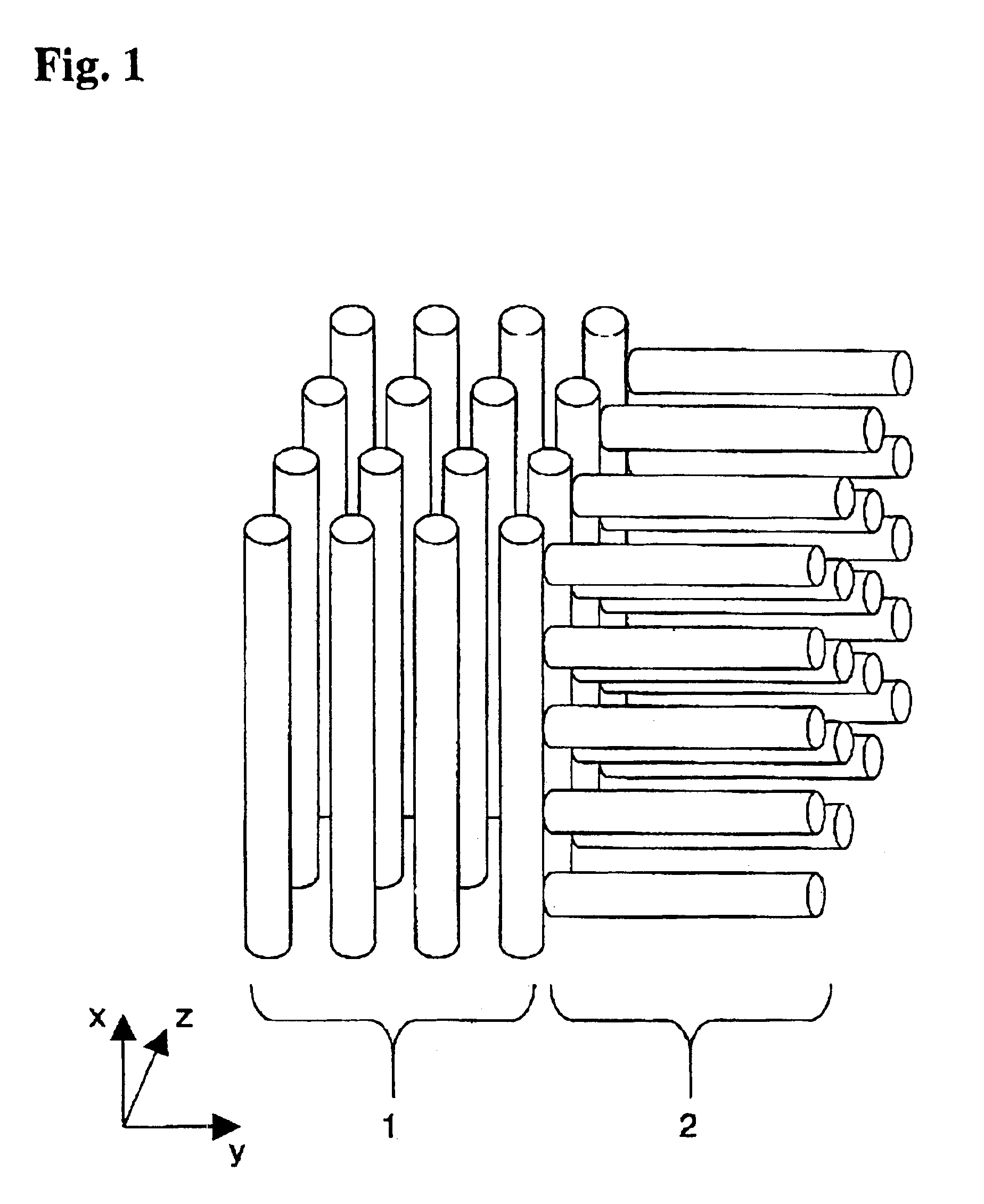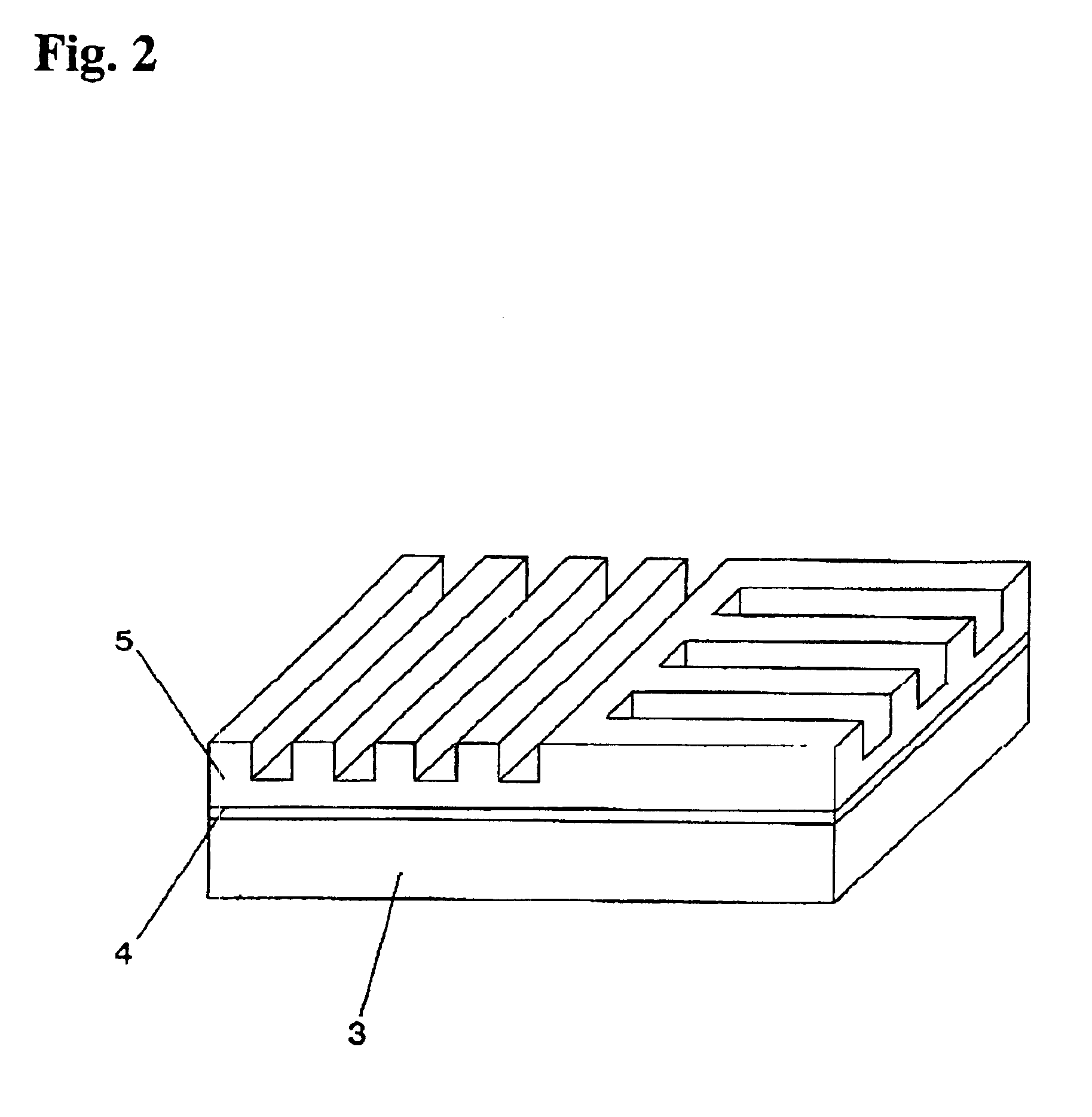Integrated optical element
a technology of optical elements and optical elements, applied in the direction of optical waveguide light guides, instruments, nanotechnology, etc., can solve the problems of inability to realize crystal axes with different directions at optional locations in a single crystal, and inability to make a transmitted polarized light have the dependency on location
- Summary
- Abstract
- Description
- Claims
- Application Information
AI Technical Summary
Benefits of technology
Problems solved by technology
Method used
Image
Examples
embodiment 1
(Embodiment 1)
[0047]A polarizing element of the portion designated by symbol 3 in FIG. 3 is described. In the figure, symbol 8 is an amorphous SiO2 layer (SiO2 layer) and symbol 9 is an amorphous Si layer (Si layer). The period Lx in the x-axis direction is 0.5 μm and the period Lz in the z-axis direction is 0.57 μm. The SiO2 layer 8 and the Si layer 9 each have a zigzag shape along the x-axis direction. Symbol 7 shows a structure obtained by turning a structure of symbol 6 by 90 degrees.
[0048]Next, a method for making this structure is described.
[0049]First, a periodical resist pattern is formed on a substrate by means of an electron beam lithography technique. The width of the groove is 0.25 μm, the depth is 0.2 μm and the period in the transverse direction is 0.57 μm. FIG. 2 shows a schematic figure of it. Symbol 3 is a substrate, symbol 4 is a reflection-free coating layer, and symbol 5 is a periodical groove portion. Generally, according to selection of the dimensions of a peri...
embodiment 2
(Embodiment 2)
[0060]In a similar structure to the portion of symbol 3 in FIG. 3, by properly determining the period of the pattern on a substrate and the period of deposition, it is possible to make the structure act as a wave plate providing an optional phase difference between polarized lights being perpendicular to each other. That is, a structure as shown in FIG. 3 provides an optical element with wave plates whose optical axes are directed in different directions according to locations, combined together. Further, since a structure with the same period of deposition can be made to act as a ½-wavelength plate or a ¼-wavelength plate by changing the period of the pattern of a substrate, it is possible to realize a ½-wavelength plate and a ¼-wavelength plate at the same time on a single substrate by making the period of the substrate different according to locations.
[0061]As application of such a device, there is an optical circulator (Japanese Patent Laid-Open Publication No.Hei ...
embodiment 3
(Embodiment 3)
[0063]Regions that are different by 90 degrees in direction of grooves from each other are alternately arranged two-dimensionally like a pattern shown in FIG. 6. In such a structure, assuming that the structures in symbol 13 and symbol 14 are similar to those of symbols 6 and 7, the portion of symbol 13 reflects a polarized light in the x direction and transmits a polarized light in the y direction. On the other hand, the portion of symbol 14 transmits a polarized light in the x direction and reflects a polarized light in the y direction. By making the region of symbol 13 and the region of symbol 14 equal in area to each other, any polarized light of an incident light in the z direction is reflected by one of regions of symbols 13 and 14 and is transmitted by the other. That is, an optical element can be produced in which 50% of incident power is reflected and the other 50% of it is transmitted regardless of the polarized state of the incident. This action is possible ...
PUM
| Property | Measurement | Unit |
|---|---|---|
| depth | aaaaa | aaaaa |
| depth | aaaaa | aaaaa |
| depth | aaaaa | aaaaa |
Abstract
Description
Claims
Application Information
 Login to View More
Login to View More - R&D
- Intellectual Property
- Life Sciences
- Materials
- Tech Scout
- Unparalleled Data Quality
- Higher Quality Content
- 60% Fewer Hallucinations
Browse by: Latest US Patents, China's latest patents, Technical Efficacy Thesaurus, Application Domain, Technology Topic, Popular Technical Reports.
© 2025 PatSnap. All rights reserved.Legal|Privacy policy|Modern Slavery Act Transparency Statement|Sitemap|About US| Contact US: help@patsnap.com



